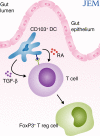Oral tolerance: is it all retinoic acid?
- PMID: 17620364
- PMCID: PMC2118658
- DOI: 10.1084/jem.20071251
Oral tolerance: is it all retinoic acid?
Abstract
Oral tolerance has been argued to depend on "special" presentation of antigen in the gut. New studies support this idea by showing that the catalysis of vitamin A into retinoic acid (RA) in gut-associated dendritic cells (DCs) enhances the transforming growth factor (TGF)-beta-dependent conversion of naive T cells into regulatory T (T reg) cells and also directs T reg cell homing to the gut. These results reveal new tolerance mechanisms that will aid the use of T reg cells in the clinic.
Figures


Comment on
-
A functionally specialized population of mucosal CD103+ DCs induces Foxp3+ regulatory T cells via a TGF-beta and retinoic acid-dependent mechanism.J Exp Med. 2007 Aug 6;204(8):1757-64. doi: 10.1084/jem.20070590. Epub 2007 Jul 9. J Exp Med. 2007. PMID: 17620361 Free PMC article.
-
Small intestine lamina propria dendritic cells promote de novo generation of Foxp3 T reg cells via retinoic acid.J Exp Med. 2007 Aug 6;204(8):1775-85. doi: 10.1084/jem.20070602. Epub 2007 Jul 9. J Exp Med. 2007. PMID: 17620362 Free PMC article.
-
All-trans retinoic acid mediates enhanced T reg cell growth, differentiation, and gut homing in the face of high levels of co-stimulation.J Exp Med. 2007 Aug 6;204(8):1765-74. doi: 10.1084/jem.20070719. Epub 2007 Jul 9. J Exp Med. 2007. PMID: 17620363 Free PMC article.
References
-
- Faria, A.M., and H.L. Weiner. 1999. Oral tolerance: mechanisms and therapeutic applications. Adv. Immunol. 73:153–264. - PubMed
-
- Mora, J.R., M.R. Bono, N. Manjunath, W. Weninger, L.L. Cavanagh, M. Rosemblatt, and U.H. von Andrian. 2003. Selective imprinting of gut-homing T cells by Peyer's patch dendritic cells. Nature. 424:88–93. - PubMed
Publication types
MeSH terms
Substances
LinkOut - more resources
Full Text Sources
Other Literature Sources

